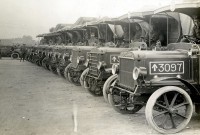- Home
- Business Processes
- Industry Knowledge
- Aerospace Industry
- Automotive Industry
- Banking Domain
- BFSI Industry
- Consumer/ FMCG Industry
- Chemicals Industry
- Engineering & Construction
- Energy Industry
- Education Domain
- Finance Domain
- Hospitality Domain
- Healthcare Industry
- Insurance Domain
- Retail Industry
- Travel and Tourism Domain
- Telecom Industry
- Leadership Skills
- eLearning
- Home
- Industry Knowledge
- Automotive Industry
- Automotive Industry: Industry Sectors
Automotive Industry: Industry Sectors
In this article, we will discuss the business sectors of the automotive industry. We will understand the major sectors in the automotive industry and the role they play and their impact on the industry. The major business sectors of the automotive industry are suppliers, auto-manufacturers, and auto dealerships.
Pillars of the Automotive Industry:
The automotive industry can be divided into three business sectors that form the pillars of the industry. The three business sectors are:
Car and Automobile Manufacturers:
Companies in this industry manufacture chassis for automobiles and light-duty motor vehicles and assemble final automobiles and light-duty motor vehicles. These vehicles include passenger cars, pickup trucks, sports utility vehicles (SUVs), crossover utility vehicles, people movers, and vans. Many parts are acquired from many different suppliers and finally assembled by the Auto Manufacturer. They use these parts to build vehicles and the assembled vehicle is sold under their brand names. Auto manufacturers produce and sell light-duty vehicles, such as passenger cars, vans, and pickup trucks. They also sell heavy-duty vehicles, such as trucks, transit buses, school buses, and military vehicles.
Industry Products:
- Cars
- Pickup trucks and SUVs
- Vans
- Trucks
- Transit Buses
- School Buses
- Military Vehicles
Industry Activities:
- Manufacturing passenger cars, light trucks, sport utility vehicles and vans
- Manufacturing chassis for passenger cars, light and utility trucks, and vans
- Manufacturing electric automobiles for highway use
- Hearses assembling on chassis of own
Auto Parts and Accessories Manufacturers:
Companies in this industry manufacture motor vehicle parts and accessories other than engines, engine parts, batteries, tires, bodies, and chassis. Motor vehicle assembling is not included in this industry. Manufacturers typically supply parts and accessories to original equipment manufacturers (OEM) for use in the manufacturing of complete motor vehicles or for replacement parts in OEM dealerships. They also supply parts to the aftermarket.
Suppliers form part of a highly complex supply chain that transforms raw materials and components into ready-made auto parts that are then delivered to auto manufacturers. The supplier business sector also includes aftermarket parts, replacement parts, and rubber fabrication companies.
Industry Products:
- Electrical and electronic components
- Steering and suspension
- Brake systems
- Transmission and power train
- Seating and interior trim
- Metal stamping
- Air conditioning, airbag, wheel, and all other parts
Industry Activities:
- Motor vehicle electrical and electronic part
- Motor vehicle steering and suspension part
- Motor vehicle brake system
- Motor vehicle transmission and power train part
- Motor vehicle seating and interior trim part
- Motor vehicle part metal stamping
Car & Automobile Sales / Auto Dealerships:
This industry is involved in the retailing of new and used motor vehicles mainly through dealerships, commission agents, and car auctions. Products sold in this industry include passenger cars, SUVs and light trucks, heavy trucks, buses, recreational vehicles, and specialty vehicles such as ambulances and fire trucks. Retail sales of motorcycles, mopeds, and bicycles are not included in this industry.
Auto dealerships distribute the finished vehicles to the customers. They trade in new vehicles and there also exists a huge demand and market for used vehicles. These dealerships can deal in either new or used or both. Generally, dealerships also provide additional services for vehicle owners, such as vehicle maintenance services and replacement parts. Some dealerships also arrange financing options for vehicle buyers.
Industry Products:
- Cars
- Sports utility vehicles and pickup trucks
- Light commercial vehicles
- Heavy trucks
- Buses
- Recreational vehicles
- Specialty vehicles
Industry Activities:
- Sales and service of cars and light trucks
- Sales and service of heavy trucks
- Sales and service of specialty vehicles
- Sales and service of buses
- Sales and service of vans and other commercial vehicles
- Sales and service of recreational vehicles
Suggested Reading and Resources on Automobile Domain
| Supply & Value Chain | Industry Sectors | The Competitive Landscape |
| Industry Drivers | History of Automotive Industry | Overview of Automotive Industry |
Related Links
You May Also Like
-
History of Automotive Industry
The study of the automotive industry is inherently interesting: it is massive, it is competitive, and it is just a few years older than a century. It is expected to undergo major changes in recent times due to the impact of globalization, increased regulations because of environmental concerns, and rising fossil fuel prices due to decreasing oil reserves.
-
Automotive Industry Supply & Value Chain
Most of the automotive manufacturers employ a business model that demands collaboration between different assemblers and cadre of parts suppliers with a lean, flexible, just-in-time (JIT) assembly process. In this article, we will discuss the business model of a typical automotive manufacturer and the various stages from planning to final retailing of the product.
-
Automotive Industry: Industry Sectors
In this article, we will discuss the business sectors of the automotive industry. We will understand the major sectors in the automotive industry and the role they play and their impact on the industry. The major business sectors of the automotive industry are suppliers, auto-manufacturers, and auto dealerships.
-
Overview of Automotive Industry
The first automobile with a petrol engine was built in 1885 and soon the figure for total cars in the world will be touching a mark of 1000 million cars and light trucks. This article presents a quick overview of what we mean with the Automative Industry and how it started and what is the scale of this industry today.
-
Automotive Industry: The Competitive Landscape
In this article, we will discuss the top key competitors in the automotive industry. This will help you gain an understanding of the major players in the automotive industry. We will start with a brief history of the major players, their competitive advantage, and financial profiles in this section.
-
Automotive Industry: The Key Industry Drivers
There are four key business drivers that impact the automotive industry: economic conditions, consumer preferences, government, and technological advances. Globalization is also influencing the industry to a great extent. In this article, we will discuss in detail each of these business drivers.
Explore Our Free Training Articles or
Sign Up to Start With Our eLearning Courses

About Us
Learning
© 2023 TechnoFunc, All Rights Reserved






